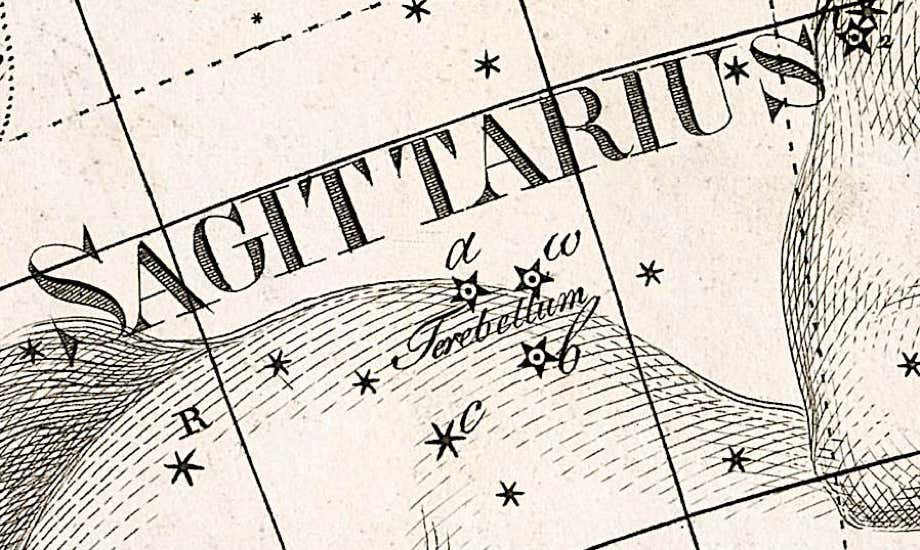
Genitive: Sagittarii
Abbreviation: Sgr
Size ranking: 15th
Origin: One of the 48 Greek constellations listed by Ptolemy in the Almagest
Greek name: Τοξότης (Toxotes)
Sagittarius is depicted in the sky as a centaur, with the body and four legs of a horse but the upper torso of a man. He is shown wearing a cloak and drawing a bow, aimed in the direction of the neighbouring scorpion, Scorpius. Aratus spoke of the Archer, Τοξότης (Toxotes), and his Bow, Τόξον (Toxon), as though they were separate constellations. Most likely this is because the stars of the bow and arrow are the most distinctive part of the figure. They form the asterism that we now know as the Teapot (see below).
Sagittarius, the centaur-like archer, shown drawing his bow on Chart XV of the Uranographia of Johann Bode (1801). By his forefeet is the constellation Corona Australis.
A confusion of identity
Sagittarius is a constellation of Sumerian origin that represented PA.BIL.SAG, a god of war and hunting who they depicted as a centaur-like archer with wings. The Sumerian figure was subsequently adopted by the Greeks, although without the wings. As a result there are no particular myths associated with this constellation and the Greek mythographers were confused as to its identity.
Some doubted that this was a centaur at all, among them Eratosthenes who gave as one of his reasons the fact that centaurs did not use bows. Instead, Eratosthenes described Sagittarius as a two-legged creature with the tail of a satyr. He said that this figure was Crotus, son of Eupheme, the nurse to the Muses, who were nine daughters of Zeus. The Roman mythographer Hyginus in his Fabulae added the information that the father of Crotus was Pan, agreeing with Eratosthenes that the archer was a satyr rather than a centaur.
Crotus was said to have invented archery and often went hunting on horseback. He lived on Mount Helicon among the Muses, who enjoyed his company. They sang for him, and he applauded them loudly. The Muses requested that Zeus place him among the stars, where he is seen demonstrating the art of archery. In the sky he was given the hind legs of a horse because he was a keen horseman.
Aratus and Ptolemy, though, both spoke of the archer as a four-legged creature, which is how he is usually depicted. Ptolemy described him with a flowing cloak, known as the ephaptis (ἐφαπτίς), attached at his shoulders. By his forefeet is a circle of stars that Hyginus said was a wreath thrown off by the archer ‘as though at play’. This circlet of stars is the constellation Corona Australis.
Sagittarius was sometimes misidentified as Chiron, a wise and scholarly centaur. But Chiron is in fact represented by the other celestial centaur, the constellation Centaurus.
Stars of Sagittarius
Alpha Sagittarii is called Rukbat, from the Arabic rukbat al-rāmī, ‘knee of the archer’. Beta Sagittarii is a naked-eye double; the two components are called Arkab Prior and Arkab Posterior, Arkab coming from the Arabic word ‘urqūb meaning ‘Achilles tendon’. Gamma Sagittarii is Alnasl, from the Arabic al-naṣl meaning ‘the point’, referring to the tip of the archer’s arrow.
Delta, Epsilon, and Lambda Sagittarii are respectively called Kaus Media, Kaus Australis, and Kaus Borealis. The word Kaus comes from the Arabic al-qaus, ‘the bow’, while the suffixes are Latin words signifying the middle, southern, and northern parts of the bow. Zeta Sagittarii is Ascella, a Latin word meaning ‘armpit’. All these names closely follow the descriptions of the stars’ positions given by Ptolemy in his Almagest.
Last, but not least, is Sigma Sagittarii, called Nunki. This name was applied relatively recently by navigators, but it was borrowed from a list of Babylonian star names. The Babylonian name NUN-KI was given to a group of stars representing their sacred city of Eridu on the Euphrates. The name has now been applied exclusively to Sigma Sagittarii, and is reputed to be the oldest star name in use.
Ptolemy in the Almagest inexplicably classified the stars that we know as Alpha and Beta Sagittarii as second magnitude, when they are in fact fourth. Bayer, who lived too far north to see these stars for himself, accepted Ptolemy’s assessment and labelled them Alpha and Beta. (Al-Ṣūfī had corrected the mistake in his Book of the Fixed Stars, but Bayer ignored him.) In fact, Alpha Sagittarii is only the 15th brightest star in the constellation, over seven times fainter than the brightest of all, Epsilon, which is mag. 1.8 (wrongly assessed by Ptolemy as third magnitude).
Terebellum, the quadrilateral in the tail
On the centaur’s rump is a kite-shaped group of four 5th-magnitude stars that Bode labelled Terebellum, a name first given by Johann Bayer in the notes to his Uranometria atlas of 1603. It is derived from the Greek word τετράπλευρον (tetrapleuron) meaning quadrilateral, which was used by Ptolemy not in the Almagest but in his Tetrabiblos, a later four-part work on astrology; writing about the stars of Sagittarius in Book 1, Chapter 9, he referred to the group as ‘the quadrilateral in the tail’.
The name Terebellum is now officially applied to the northernmost member of the group, Omega Sagittarii, magnitude 4.7. This was the only one of the four to which Bayer assigned a Greek letter, despite the fact that 59 and 62 Sagittarii (mags. 4.5 and 4.6 respectively) are slightly brighter.
Tea, with milk
Among present-day astronomers, the shape outlined by the eight main stars of Sagittarius (Gamma, Delta, Epsilon, Lambda, Phi, Sigma, Tau, and Zeta) is popularly known as the Teapot. Its handle consists of Phi, Sigma, Tau, and Zeta, the top of the lid is marked by Lambda, while Delta, Epsilon, and Gamma are the triangular spout. This same group of stars, with the addition of Mu Sagittarii, was originally visualized as the archer’s bow and arrow.
A subset of these stars – Lambda, Phi, Sigma, Tau, and Zeta – form a ladle shape called the Milk Dipper, fittingly placed in a rich area of the Milky Way. Ancient Chinese astronomers also imagined a dipper among these same stars (see below).
Sagittarius contains dense Milky Way star fields that lie towards the centre of our Galaxy. The exact centre of the Galaxy is believed to be marked by a radio-emitting source that astronomers call Sagittarius A*, near the border with Ophiuchus, close to the point of the archer’s arrow.
Chinese associations
Sagittarius contained two ancient Chinese constellations after which the seventh and eighth lunar mansions were named: Ji and Dou. Ji (‘winnowing basket’) consisted of four stars – Gamma, Delta, Epsilon, and Eta Sagittarii – and represented a basket used for separating rice grains from chaff by shaking it in the air. The chaff, blown away by the breeze, is represented by a single star nearby called Kang, although opinions differ as to whether Kang lay in Sagittarius, Scorpius, or even Ophiuchus. A related constellation was Chu, the pestle, to the south of Ji in Ara, for pounding the rice to remove the husks.
Dou (‘dipper’, also known as Nandou, ‘southern dipper’) was formed by Mu, Lambda, Phi, Sigma, Tau, and Zeta Sagittarii. These same stars, bar Mu, form the present-day asterism called the Milk Dipper. In a Chinese proverb, the southern dipper marks life while the northern dipper (Beidou, our Big Dipper in Ursa Major) marks death. A single star nearby, probably 5th-magnitude HR 7029, was Nongzhangren, an old farmer, perhaps measuring out grain with the dipper and using the winnowing basket.
To the north of Dou the arc formed by Upsilon, Rho, 43, Pi, Omicron, and Xi Sagittarii was known as Jian, representing a flag or banner, perhaps at a city gate. Next to this was Tianji, ‘celestial cock’, formed by 55 and 56 Sagittarii; the bird represented by this constellation was said to be in charge of time, because it was the first to crow at dawn and all others followed it.
South of Tianji were two canine-related constellations. Gouguo consisted of Omega, 59, 60, and 62 Sagittarii. The name Gouguo is translated as ‘land of dogs’ or ‘dog kingdom’; it could represent a nation that appears in a Chinese fable or it may simply be an area for dogs around a farm. Next to it was Gou, formed by 52 and Chi-1 Sagittarii, representing a guard dog.
In southern Sagittarius, ten stars probably including Alpha and Beta formed Tianyuan, representing a body of water such as a lake or sea. It was said to govern the irrigation of fields. Some faint stars in Sagittarius on the border with Ophiuchus, identities uncertain, formed part of Tianyue. Lying exactly on the ecliptic, Tianyue represented a lock or keyhole through which the Sun had to pass every year. It lay directly opposite in the sky from Tianguan, a gate on the ecliptic in Taurus.
© Ian Ridpath. All rights reserved
Bayer noted in his Uranometria atlas that the star he labelled c Sagittarii (number 31 in Ptolemy’s catalogue) was the hindmost of a group of four that were known as Terebellum or τετράπλευρον (quadrilateral) in Greek.
Bode labelled a group of four stars on the rump of Sagittarius with the name Terebellum, originally applied by Johann Bayer and derived from the Greek meaning quadrilateral. The name Terebellum is now given officially to the star labelled Omega (ω). The other four, here labelled a, b, and c, are known respectively as 60, 59, and 62 Sagittarii.





